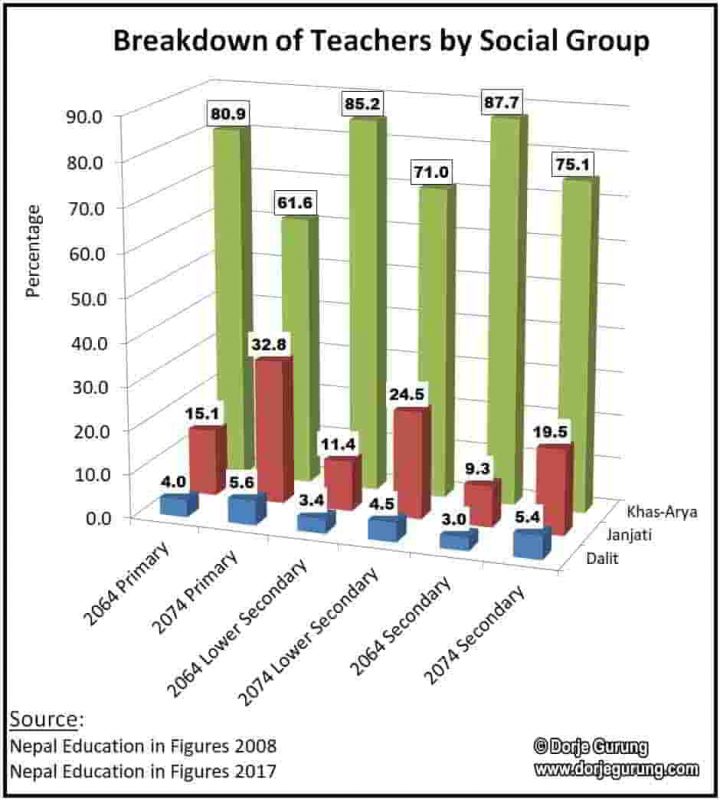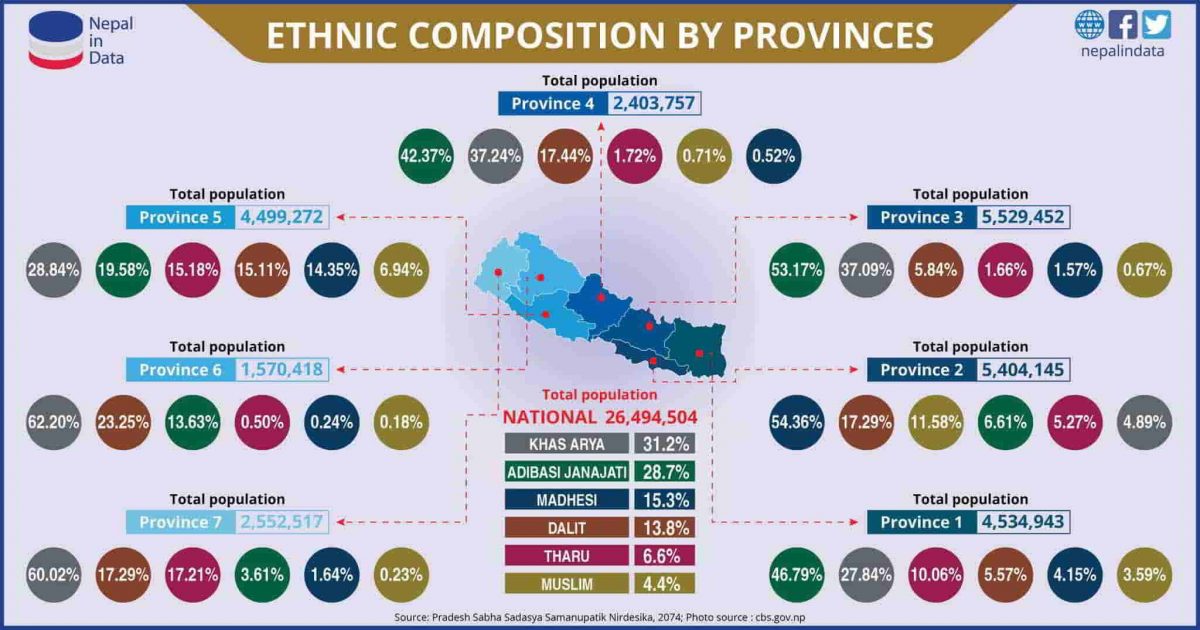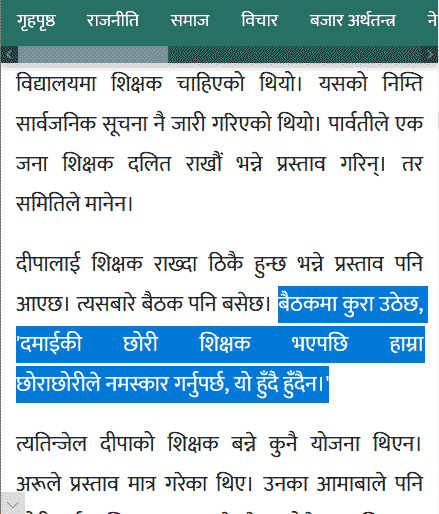Studies have shown representation matters for many reasons and in many ways, ways many of which are hard to pinpoint and quantify. But, sadly, that’s something we ONLY give lip service to in Nepal.
In this blog post, I’ll arguing how the severe lack of diversity in the teaching fraternity in the country is likely negatively impacting the learning outcomes and/or academic achievements of students, which in turn likely affects their lives later and, indirectly, the society and country.
Here’s a breakdown of teachers in schools (see chart below). An educated assumption had to be made in creating the chart because the source did NOT spell it out. Namely that, all teachers who aren’t Dalit or Janjati (indigenous population) are Khas-arya, the Hill so-called high castes. Of course, there’s bound to be some errors there. Regardless, I would put the percentage of Khas-arya at above 50%, i.e. the majority.

Here’s a breakdown of the population of the country (middle column).

So, in a country with about 69% non-Khas-arya, as recently as five years ago a majority of teachers were Khas-aryas.
Anyone who has been an educator for long knows that teacher-student relationship is one of the most important — if not THE most important — factor in student learning and achievement. In a country where casteism is strongly rooted — many expressions of it internalized, unconscious, and, worse, are even the norm — relationship between individuals, including that between a teacher and a student, is ALSO influenced by their caste identities. But of course, not known for our research or scholarship in general or specifically on that subject, we don’t have any studies to back that assertion up with.
Studies in the US have shown a relationship between race and the way students are treated by the teachers, between race and teachers’ expectations of students, and between race and academic achievements of students. Professor Dan Battey in his study titled, “Racial Mis(Match) in Middle School Mathematics Classrooms: Relational Interactions as a Racialized Mechanism,” found white teachers to be “three times more negative with black students than with white[.]”
[W]hite teachers were three times more negative with Black students than with white students, showing that critical phases of development for Black children could be hindered through daily interactions with their teachers.
Furthermore, he also discovered the following.
On the other hand, Black teachers were found to be less negative toward Black students. They were equally as positive as white teachers though. Battey said these teachers were in the same schools and teaching kids from the same neighborhoods, yet they were acting differently, indicating that there were possibly internalized stereotypes about who the students were. [Emphasis mine.]
Another study found more evidence for representation being an issue in American schools. Their studies suggested “that white teachers expect less academic success from black students than black teachers from the same students.”
In yet another sign that the lack of teacher diversity is a pressing issue, a new study suggests that white teachers expect less academic success from black students than black teachers do from the same students.
The study, conducted by Johns Hopkins University, found that when a white teacher and a black teacher consider the same black student, the white teacher is 30 percent less likely to think the student will graduate from a four-year college. White teachers, the researchers also found, are nearly 40 percent less likely to think their black students will graduate from high school.
The studies further suggest “that low expectations from some teachers might engender low performance from students.”
The research, which involved an analysis of data from the Educational Longitudinal Study of 2002, a national study of more than 8,000 10th-grade students, suggests that low expectations from some teachers might engender low performance from students. The researchers found that when black students had a non-black teacher in a particular 10th-grade subject, they were much less likely to enroll in similar classes subsequently, suggesting teacher bias may have long-term consequences. More than 80 percent of public-school teachers are white, and the vast majority are women. [Emphasis mine.]
What happens in classrooms in Nepal where the issue is NOT race but caste? When majority of teachers are Khas-arya, the hill so-called high caste Hindus, representing only 31% of the population, what’s the impact?
Of course, again, we have NO studies or research to rely on for conclusions etc. All we have are anecdotes.
Teachers and educators in general have low expectations of, low opinions about, and, worse, flagrantly discriminate against both Dalit — the so-called lowest caste — students and teachers in many ways, such as being more negative, for example!
Sona Khatik, a Dalit woman, was “insulted, isolated and humiliated” by her “teachers” too, in addition to by members of her community when growing up.
She also recalls experiences of being insulted, isolated and humiliated in school from fellow students and teachers. “They didn’t treat me like a human being,” Sona says, “I dreaded going to school and couldn’t even sleep at night.” [Emphasis mine.]
Pandak Malik, a Dalit man, recalling his schooling experiences, had this to say:
The teachers, saying [using the pejorative and therefore demeaning form of the pronoun you], “If you want to study, you still have to follow the tradition of the village,” would send me to the back. Some teachers refused to grade my notebooks.
Headlining ‘Even a Teacher Says, “What are you going to do with education?”‘ (सरले नै भन्छन्– पढेर के गर्छौ?), a Dalit girl in 11th grade, describing her educational journey, recalls all the ways her teachers flagrantly discriminated against her and demeaned her outright.
Granted they are the experiences of just a few but, from what I have gathered, they are representative. Dalits make up almost 14% of the population. Worse, those are the experiences of those who make it to school. From what I understand, a significant percentage of Dalits, who suffer from abject poverty, don’t even make it to school, forget to well-regarded private schools.
Speaking at different private schools in Kathmandu, one of the things I used to do was to get a sense for the breakdown of the students in the audience by caste. And invariably, it was rare to find a Dalit student in the audience. Most often, there would be none, as was the case at Ullens School, one of the most expensive and reputable schools in the entire country. Here’s a video of that part of the presentation.
Forget teachers and administrators treat Dalit students equitably; they even deny that there is discrimination against them. According to this article, a six — SIX — year-old Dalit girl-child dropped out of school because of discrimination. Yet, the principal, instead of offering to investigate, gaslights, saying, “No student is ill-treated because of caste.”
Again, forget teachers and administrators treating Dalit students equitably, administrators and Nepalis even take issue with Dalits being teachers! According to this article, the Principal of a school in the Southern Plains refuses to accept the chair of the School Management Committee simply because he is a Dalit! This article details the life and struggles of a Dalit woman including about opposition she faced from her community when she tried to get employment at the local school as a teacher and her trials and tribulations as a teacher. They objected because, as far as they were concerned, “When the daughter of a tailor [a Dalit] becomes a teacher, our children will have to greet her with a ‘Namaskar,’ and that is completely unacceptable.”

Here’s the worst though! According to this article, a teacher at a school proclaimed with pride, “Bahun-Chhetri [Khas-arya] students stopped coming when the school enrolled 6 Dalit children. So I kicked out the Dalit students.” Yup, a teacher who, instead of fighting against caseism and steering the next generation of children away from it, compounded the problem and helped perpetuate it by punishing — with pride — the Dalits, the victims!
Having said that, I very much doubt ONLY Dalit students face discrimination from the predominantly hill so-called High Caste Hindu teachers and administrators in Nepal. Others, like the Janajatis, the Muslims etc. likely also face negligence and discrimination though, of course, not in the same way and likely not to the same degree.
Finally, the most important question is how much is the disproportionately high representation of hill so-called high caste in the teaching staff and administration of schools affecting or impacting the learning outcomes and academic achievements of such children and, in turn, their later lives?
In spite of the fact that almost 69% of the population of the country belong to social groups other than the hill so-called high caste, for as long as education has been available to the public, almost 70 years, its formulation, administration, and delivery have been mostly the domain of the hill so-called High Caste men. How many in the past have suffered and to what extent? How have their learning outcomes and academic achievements been impacted? What’s been the long-term impact, that is the impact on their lives as adults? And, finally, how has it impacted the society and country? How much is the society and the country suffering now as a direct or indirect consequence of that?
What do you think?
References/Additional Reading
- This blog post was mostly based on this tweet thread.
- White teachers three times more negative with Black students, Rutgers study finds
- The Impact of White Teachers on the Academic Achievement of Black Students: An Exploratory Qualitative Analysis
- White Teachers Expect Less Than Black Teachers From Black Students

